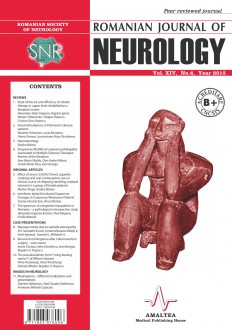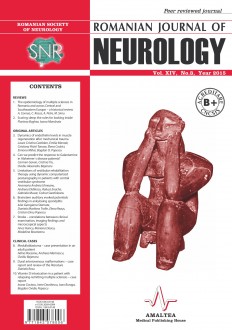SELECT ISSUE

Indexed

| |

|
|
|
| |
|
|
|

|
|
|
|
|
|
| |
|
|
HIGHLIGHTS
National Awards “Science and Research”
NEW! RJN has announced the annually National Award for "Science and Research" for the best scientific articles published throughout the year in the official journal.
Read the Recommendations for the Conduct, Reporting, Editing, and Publication of Scholarly work in Medical Journals.
The published medical research literature is a global public good. Medical journal editors have a social responsibility to promote global health by publishing, whenever possible, research that furthers health worldwide.
THE SPECTRUM OF CONGENITAL MYOPATHIES IN ROMANIA – A PATHOLOGICAL RETROSPECTIVE STUDY
Alexandra Eugenia Bastian, Vlad Mageriu and Emilia Manole
ABSTRACT
Objectives. Congenital myopathies (CM) are a highly heterogeneous group of disorders with genetic cause, characterized by motor deficit and weakness usually manifesting in the neonatal period, with slowly progressive or non-progressive course and affecting both sexes. MC classification has undergone many changes over time, and in recent years molecular genetic studies have enabled identification of novel genes and mutations, thus increasing the diagnostic complexity. We wanted to study the incidence and morphological features of the CM cases diagnosed by muscle biopsy in the Pathology Department of Colentina University Hospital over a period of 10 years (09.2005- 09.2015).
Materials and methods. We retrospectively reviewed all the muscle biopsies diagnosed with different types of CM. Muscle biopsies were performed and specifically processed using routine and special stains on cryosections, semithin and ultrathin sections for ultrastructural examination. In all the cases we reassessed the clinical and laboratory data.
Results. From a number of 1,530 peripheral nerve and muscle biopsies performed and analyzed in the 10 years period we diagnosed CM in 15 cases, representing 1.03% of the total. Of these, five were “central core myopathies”, five centronuclear/myotubular myopathies, one case of nemaline myopathy, one case of “reducing body myopathy” and three cases with congenital fiber type disproportion. Reassessment of morphological data in the clinical context allowed us to identify numerous overlaps between subtypes both in the clinical and pathological picture
Conclusions. The reduced number of MC identified in our country suggests that these diseases are probably underdiagnosed or diagnosed late, requiring a better understanding of the various clinical and pathological particularities. In the accurate diagnostic algorithm, muscle biopsy remains essential to establish the type of CM and thus to direct genetic tests.
Keywords: congenital myopathies, central cores, multiminicores, nemaline rods, centronuclear myopathy
Full text | PDF

